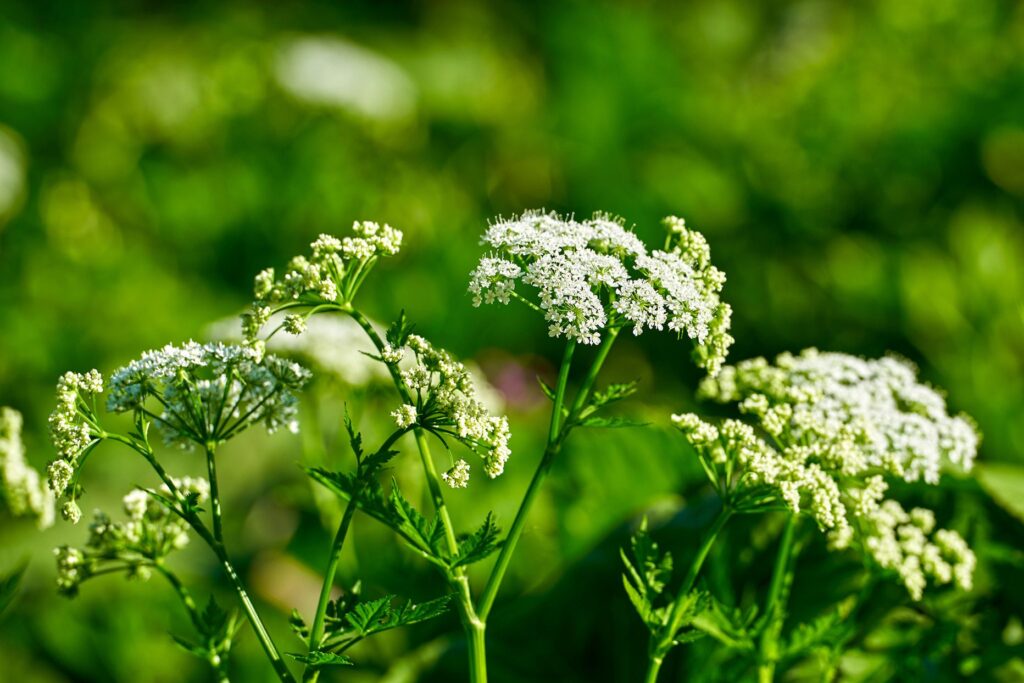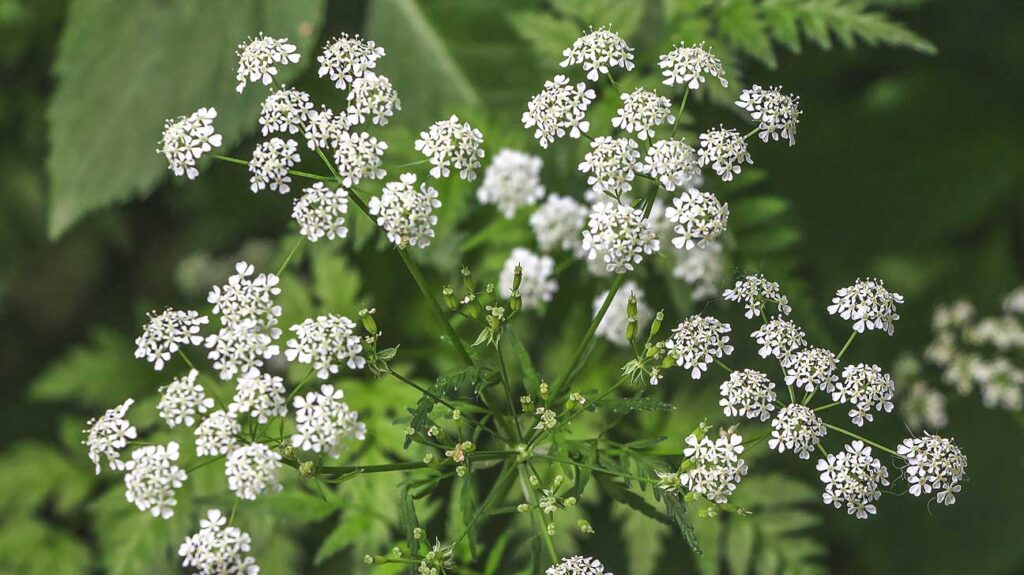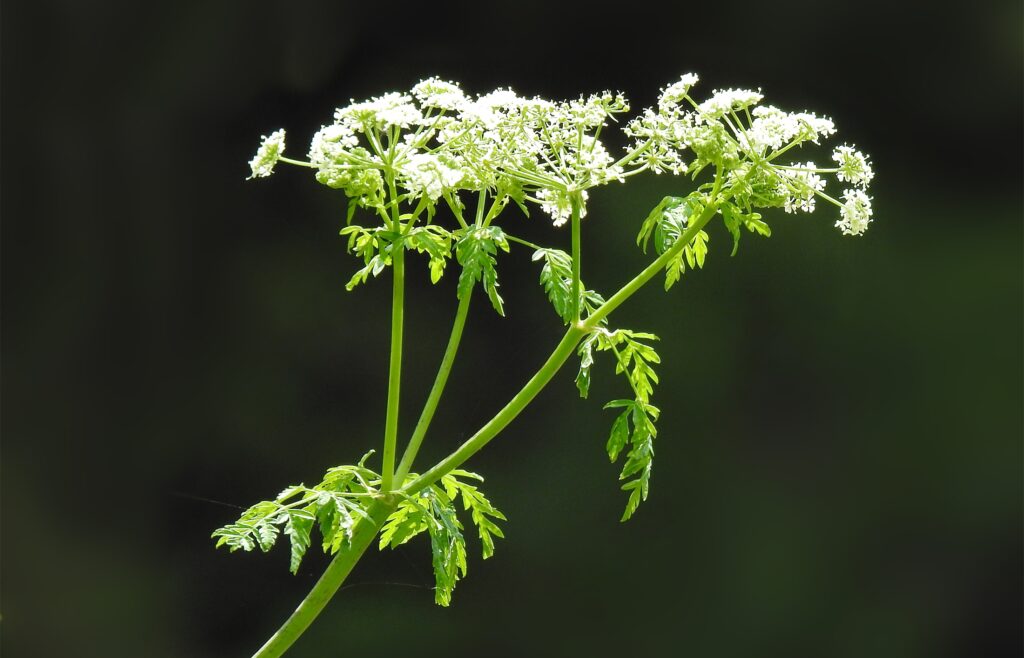Mitigate the Dangers of Poison Hemlock… a Weed that Kills
April 2024 | Native Edge Landscapes
Don’t be fooled by it’s pretty flowers. Poison hemlock is a noxious and invasive weed that can be deadly to animals and humans and difficult to manage. Here is what you need to know. If you need help, please GET IN TOUCH.

The Dangers of Poison Hemlock
Poison hemlock (Conium maculatum) is harmful due to its highly toxic nature. The plant contains several potent toxins, primarily coniine and gamma-coniceine, which affect the nervous system and can be fatal if ingested in sufficient quantities. Here’s how poison hemlock can be harmful:
- Toxicity: All parts of the poison hemlock plant, including the leaves, stems, seeds, and roots, contain toxic alkaloids. Ingesting even small amounts of the plant can lead to poisoning.
- Symptoms: Poisoning from poison hemlock typically results in symptoms such as nausea, vomiting, abdominal pain, diarrhea, weakness, trembling, seizures, respiratory failure, and death. The onset of symptoms can be rapid, especially if the plant is ingested.
- Severity: Poison hemlock toxicity can vary depending on factors such as the individual’s size, age, and overall health, as well as the amount of plant material ingested. In severe cases, poisoning can be fatal due to respiratory paralysis.
- Misidentification: One of the dangers of poison hemlock is that it resembles several other non-toxic plants, such as wild carrots, parsley or Yarrow, a popular Colorado native perennial species . This similarity can lead to accidental handling or even ingestion, especially by children or individuals unfamiliar with plant identification.
- Risk to Livestock: Poison hemlock is also toxic to livestock, including cattle, horses, sheep, and goats. Grazing animals may consume the plant unknowingly, leading to poisoning and potentially fatal outcomes.
- Environmental Impact: Poison hemlock is considered an invasive species in Boulder County, where it can outcompete native plants and disrupt ecosystems. Its toxicity poses a risk to wildlife and can affect biodiversity in affected areas. (Each plant produces around 40,000 seeds, the majority of which will germinate. There is no specific germination season for them, so they germinate spring through fall. And if left unmanaged soil can host dense stands of hemlock plants.)
How to Safely Manage Poison Hemlock
Because of the prolific seeding hemlock can take time to eradicate, no matter which technique is used. Hemlock is best handled with patience and perseverance.

- Identification: Learn to identify poison hemlock accurately. It resembles several other non-toxic plants, so ensure you can distinguish it from similar-looking species (Yarrow, . It is a biennial . The first year it only produces a rosette of foliage. The second year it blooms.
- Protection: Wear appropriate protective gear when handling poison hemlock, including gloves, long sleeves, and eye protection. This prevents direct contact with the plant’s toxins.
- Avoidance: Whenever possible, avoid areas infested with poison hemlock. This reduces the risk of accidental exposure.
- Mechanical Control: For small infestations, hand-pulling or digging out poison hemlock plants can be effective. Ensure to remove the entire root to prevent regrowth.
- Herbicides: Selective herbicides can be effective in controlling poison hemlock, but they should be used cautiously to minimize environmental impact. Follow label instructions carefully and consider consulting with a professional.
- Disposal: Properly dispose of all removed poison hemlock plants to prevent accidental ingestion by animals or humans. Do not compost the plants, as their toxins can persist.
- Monitoring: Regularly monitor areas where poison hemlock has been managed to check for regrowth or new infestations. Early detection and prompt action can prevent further spread.
- Education: Educate others in your community about the dangers of poison hemlock and how to identify and manage it safely. This can help prevent accidental exposure and spread.
- Professional Assistance: In cases of large or persistent infestations, consider seeking assistance from trained professionals or local authorities with experience in invasive species management.

Can Native Edge Landscapes help me manage my Poison Hemlock infestation?
Yes! We have knowledgeable and professional staff members ready to help!
Get In Touch
To schedule a consultation or request services please call 303-245-9166, send an email to information@nativeedgelandscapes.com or Get In Touch through our website. One of our Customer Care Representatives will be happy to help.
Learn More
Colorado Department of Agriculture Poison Hemlock Fact Sheet
Boulder County Noxious Weeds Identification Webpage
Visit the Native Edge Native Restoration and Invasive Species Mitigation Webpage
